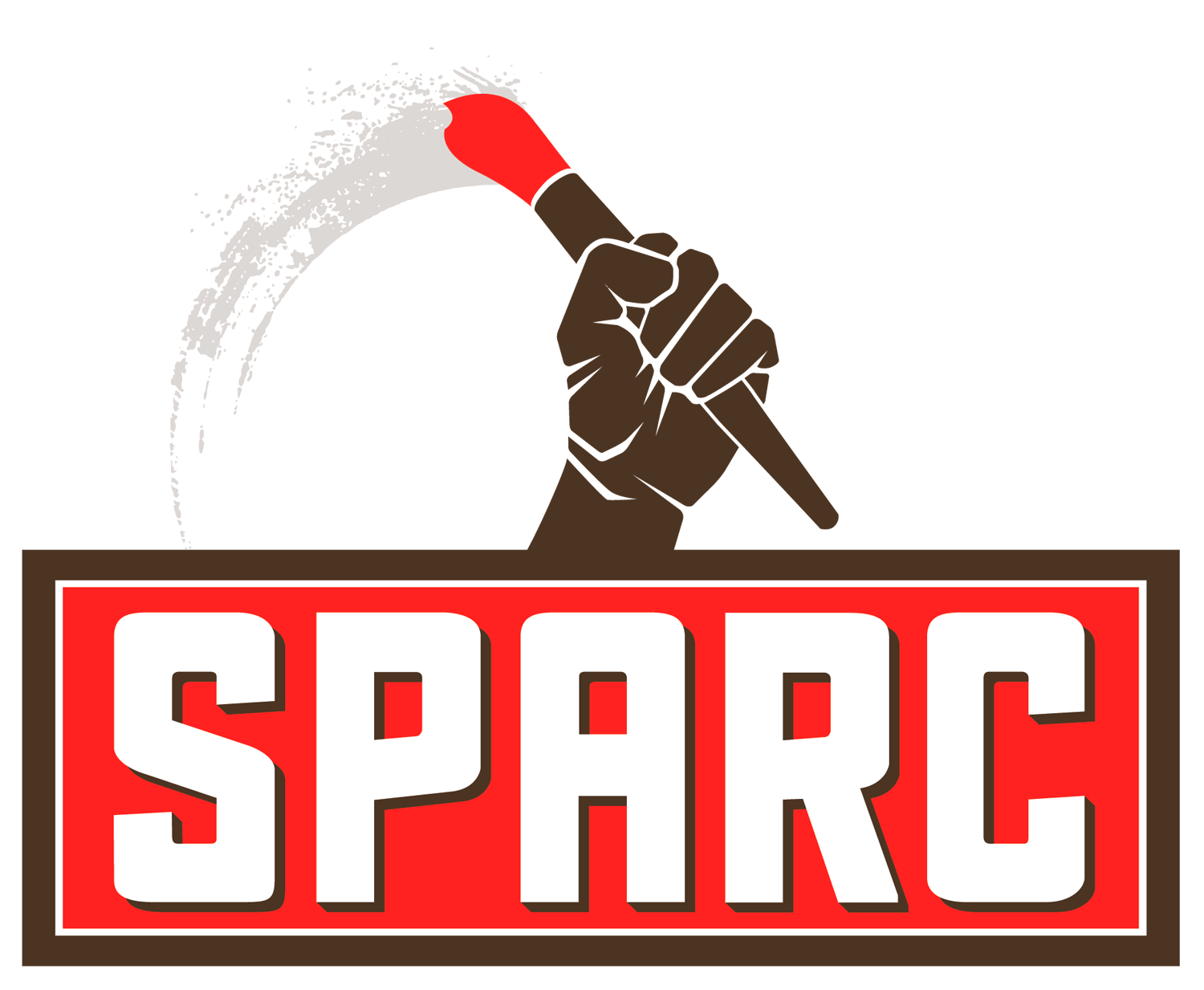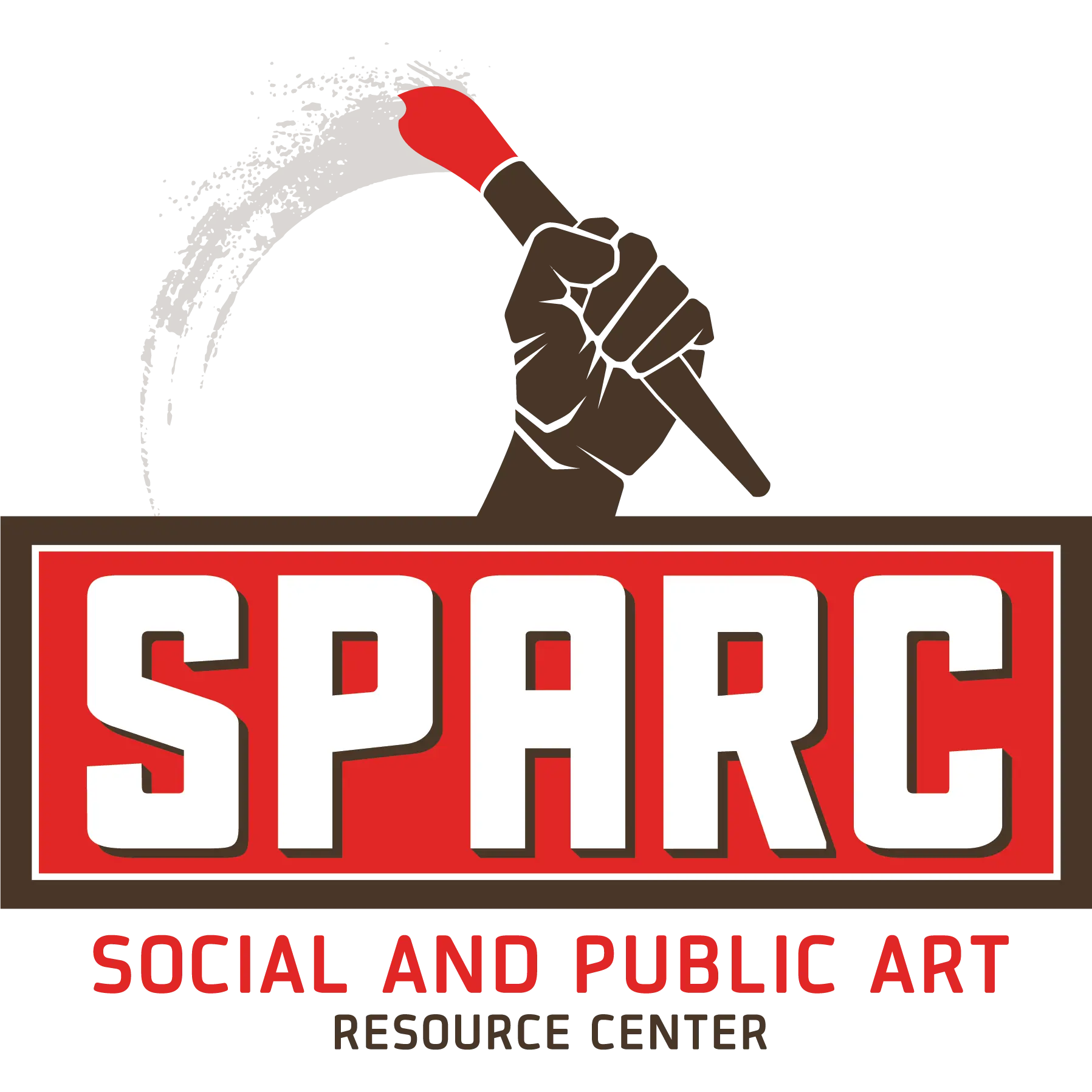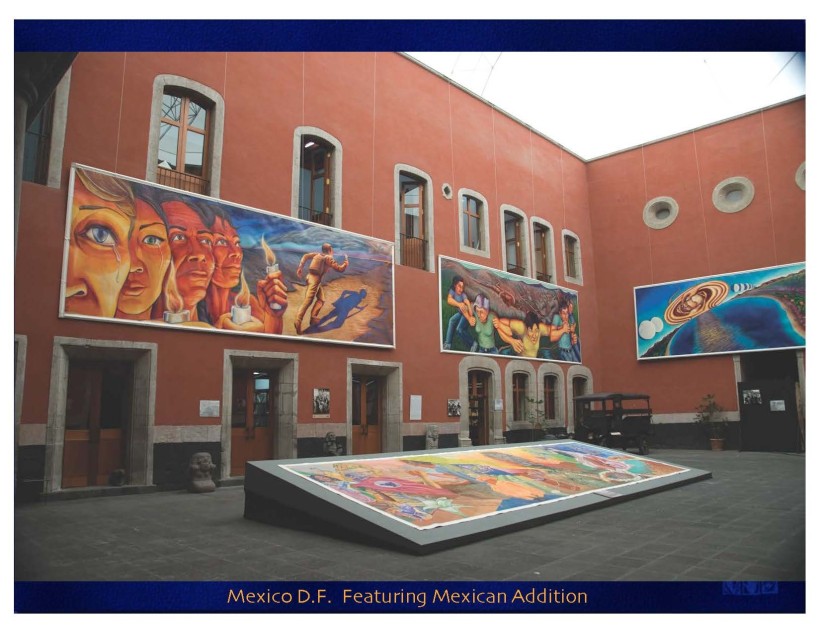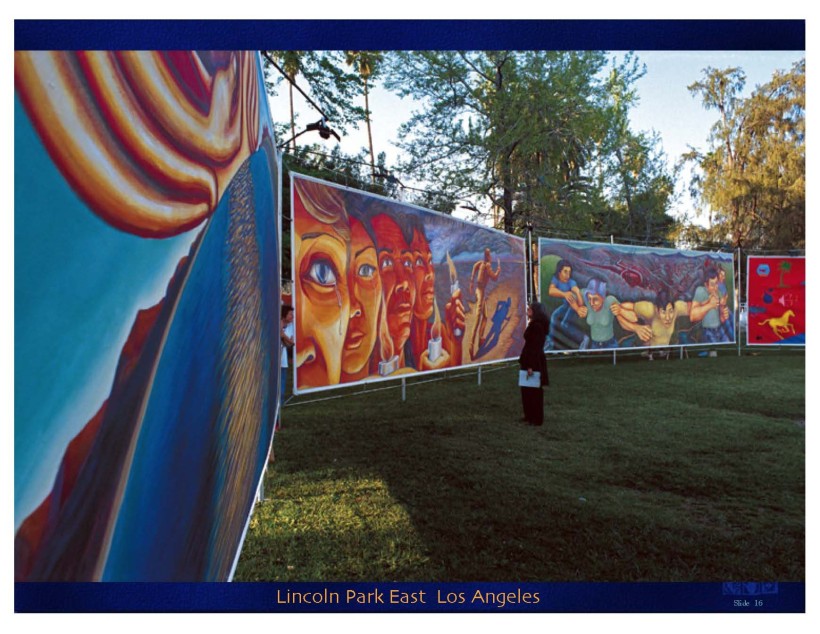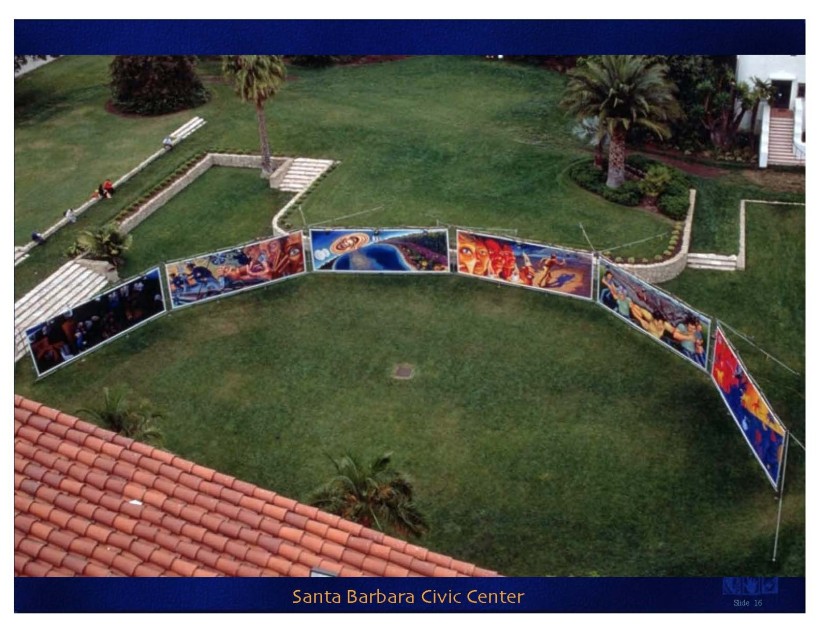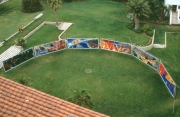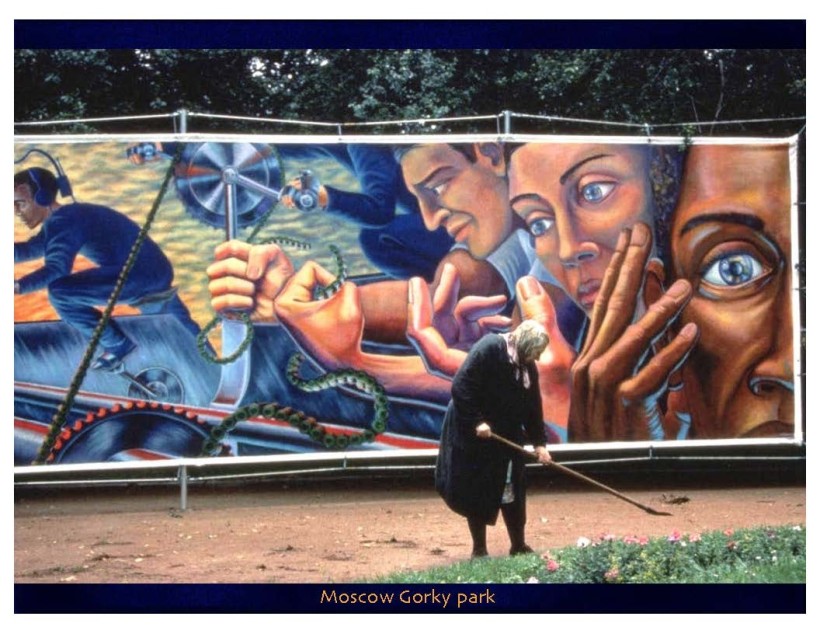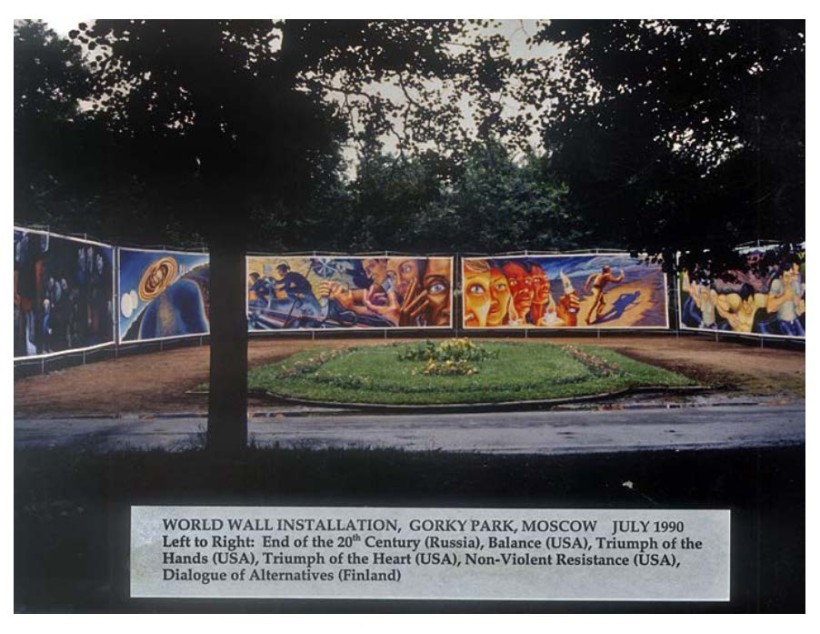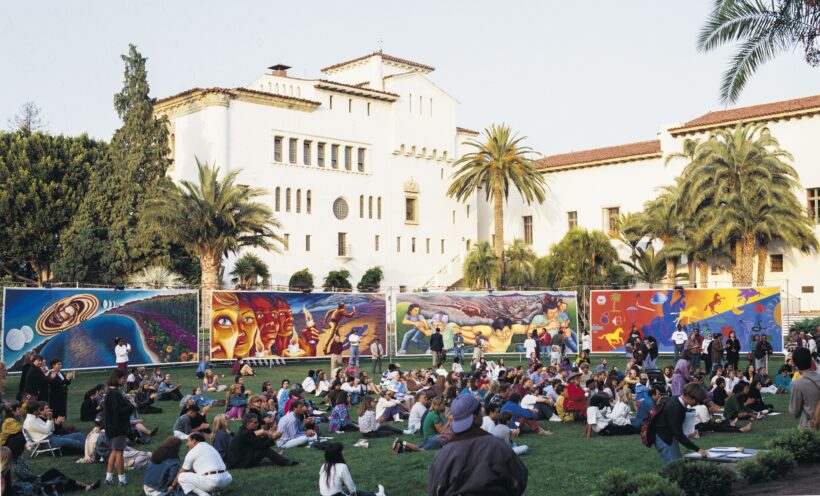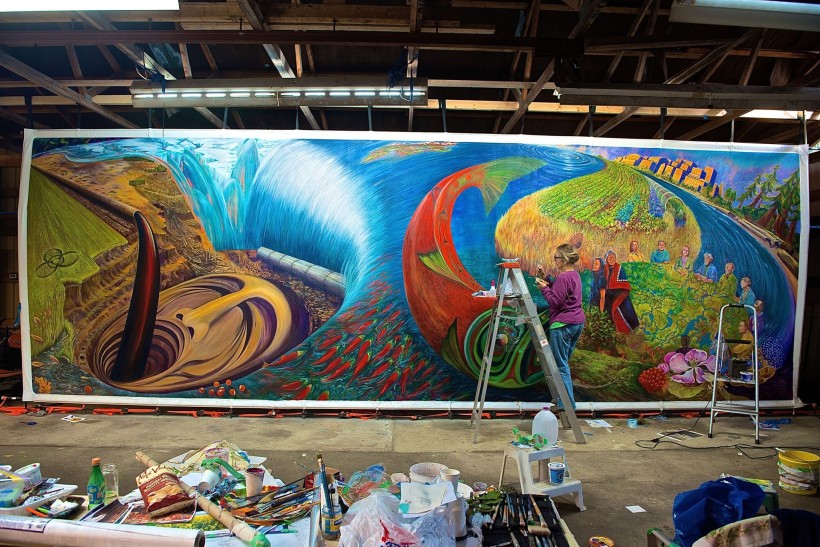World Wall
The World Wall
World Wall: A Vision of the Future Without Fear
One of the primary goals of the exhibition is to reach the widest possible audience and create an arena for dialogue. An innovative traveling installation system of poles, guy-wires and canvas frees the murals from the restrictions of conventional art exhibitions. Seven panels 10 foot by 30 foot each assemble into a 100-foot diameter circle, traveling to public spaces nationally and then internationally.
The WORLD WALL premiered in June 1990 in Joensuu, Finland at “A Meeting of the Worlds,” where Finnish artists joined the project and produced the first of a series of international panels which convey their own “Vision of the Future Without Fear.” Then it traveled to Moscow, USSR, where it was exhibited for one week in Gorky Park, and Alexi Begov, a native Russian artist, added another panel.
The WORLD WALL will travel to and be exhibited in many countries and along the way inspire activist artists all over the world to play a visionary role in imagining a peaceful future for us all, their own “Vision of the Future Without Fear”. This project, therefore, offers artists the opportunity to play an active role, to inspire individuals with bold and imaginative works that describe a peaceful society in terms that are challenging and striking and that are also well-grounded in the possible. If we speak in a language that is comprehensible and believable people will listen.
The WORLD WALL has received major funding from the following organizations and individuals: The Women’s Foundation, National Endowment for the Arts, the California Arts Council, Liberty Hill, the Rockefeller Foundation, University of California Mexus, University of California, Irvine, ARCO, Wallace Annenberg, and Bill Alexander. Many other individuals have donated time and money to make this project possible.
Assistants to Judith F. Baca on the WORLD WALL include Juan Burgueno, Regan Mc Neill, Yoko Nogami, Greg Pickens, Lilya Vorbey, and Matt Wuerker.
Artist Statement
The WORLD WALL is the next logical step for my large-scale public art work. For the past ten years I have been working on a narrative mural called the “Great Wall of Los Angeles.” Comprising the little-known history of California’s ethnic people through the 1950s, it has grown segment by segment to a half-mile length. With this work, a model production process emerged that parallels the visual content. By assessing the socio-political and cultural nature of the work, as well as the more usual aesthetic concerns, I face a series of problems to solve. Their solutions will ensure the success of the work, i.e., a true integration into its environment.
In the case of the “Great Wall,” an overriding social issue was the history of inter-racial struggle between adolescent youths who frequented the site. Multi-cultural youth teams assisting in the production of the work and focusing on the roots of racial conflicts were empowered to propose solutions both visually in wall imagery and in actuality through the establishment of interpersonal communications.
A few years ago many of us read Jonathon Schell’s Fate of the Earth, in which he said that we must imagine the eventuality of nuclear war before we can change our destiny. It occurred to me later that it was not imagining destruction that was so hard to us but rather imagining peace. One of the students on the WORLD WALL team said, “Is peace everyone sitting around watching TV?’ If we cannot imagine peace as an active concept, how can we ever hope for it to happen?
The WORLD WALL takes the successful principles developed and refined in the “Great Wall of Los Angeles” and applies them to international communication. This time I have worked with a global team of 45 students and artists to conceptualize “A Vision of the Future Without Fear.” “Great Wall” workshops and brainstorming techniques were employed to develop the proposed content. As a result of these workshops, I developed the concept of a portable mural composed of seven panels, 10′ x 30′ each, that would assemble into a 100-foot diameter circle. This system can be installed anywhere in the world and is viewed 360 degrees by an audience both standing in its center, as well as around its outer surface.
The WORLD WALL premiered in June 1990 in Joensuu, Finland at “A Meeting of the Worlds,” where Finnish artists joined the project and produced the first of a series of international panels that convey their own “Vision of the Future Without Fear.” Then it traveled to Moscow, USSR, where it was exhibited for one week in Gorky Park, and Alexi Begov, a native Russian artist, added another panel.
The WORLD WALL will travel to and be exhibited in many countries, along the way inspiring activist artists all over the world to play a visionary role in imagining a peaceful future for us all, their own “Vision of the Future Without Fear.” This project, therefore, offers artists the opportunity to actively inspire individuals with bold and imaginative works that describe a peaceful society in terms that are challenging and striking, and that are well-grounded in the possible. If we speak in a language that is comprehensible and believable people will listen.
– Judith F. Baca
Panels

Balance (1987-90) by Judith F. Baca
Balance, the central panel, builds on Native American concepts, the Hopi prophecies, and the eastern in yang. A harmonious balance has been reached and man becomes one organism in the world holding respect for other life forms.

Triumph of the Hearts (1987-90) by Judith F. Baca
Triumph of the Hearts depicts the beginning of any movement of a society towards peace: the individual taking action.

Triumph of the Hands (1987-90) by Judith F. Baca
Triumph of the Hands demonstrates the application of human energy towards human ends, the change in human labor potential for non-peaceful production to working with others in the production of more positive products that meet human needs.

Nonviolent Resistance (1987-91) by Judith F. Baca
Nonviolent Resistance presents the notion of using nonviolent means to create a societal transformation, to parallel the systems of the mainstream and create a psychic and political structure of transformation. The individual joins with others and forms a community of consciousness.

Finland
Dialogue of Alternatives (1990) by Juha Saaski, Sirkka-Liisa Lonka and Aaro Matinlaur
Dialogue of Alternatives uses universal symbols to overcome language barriers to create a codified message of alternatives and transition to hope. It is a belief that fellow artists will play an important role in the invention of a new language of the heart that will help shape a better future.

Soviet Union
The End of the Twentieth Century (1990) by Alexi Begov
The End of the Twentieth Century portrays the transition from the crucifixion of the idea of revolution to the citizens prayerfully pleading for better life, happiness, more certainty in the future, peace, charity and compassion as they look to the sky in the twentieth century. Asked to portray a “Vision of the Future Without Fear,” Soviet artist Alexi Begov’s gripping work portrays a cautious light amidst the darkness. Hope is personified in the form of a young child who, while making the sign of the cross, looks anxiously toward the future. ‘My idea of the revolution is a crucified man and three Soviets crane their necks to look skyward while a blind man gropes toward a glimmer of light with his cane

Israeli-Palestinian
The Israeli-Palestinian Panel (1998) by Ahmed Bweerat, Suliman Monsour and Adi Yekutieli
To listen, to speak, and to respect the desires of the other. Without fear of the difference of race, gender, and religion. Fifty years of armed struggle, no winners, no losers. Fifty years, marking the point of a new beginning is not worth one teardrop of a wounded child. No one raises a sword to kill a friend. We raise pen, pencils, and brushes instead and with colors design a common creation. The Inheritance: Acknowledgement, understanding, accepting the differences, having the courage to mutually explain them is what we as artists represent. Pain, suspicion, and suffering which we have lived and are still living is our children’s inheritance. Let them succeed in turning it into a new reality.

Mexican
Tlazolteotl: Fuerza Creadora de lo No Tejido (1999) by Martha Ramirez Oropeza and Patricia Quijano Ferrer
“Gestating within us, the promise of a future reborn. Captured in the net of our intertwined arts, captured in the net, the creative force of the un-woven. Our heart has a will of its own, the same hummingbird empowering our ancestors’ vision. We rebuild the forgotten roads and find a common origin. We destroy the fields of death in a ceremonial offering to our mothers and fathers. My true duality, the First Mother, forever present in the laughter that cures and tests us– We swear that we shall never again be subjected by the decrees of the heartless.”

Canadian
The Inuit Send the World a Canary (2014) by Tania Godoroja Pearse
“The central image is the salmon which is the symbol of interconnectedness between water, land, animal life and humans. The salmon is cultural keystone of West Coast First Nation peoples’ culture, art, and way of life. Its mythical cycle has been part of their lives since time immemorial. Mines and pipelines threaten to change these ways of being, irreparably. Not only are fish habitats threatened but so also is the basic human right to fresh water. Along the salmon spawning route are fish farms that further add to the demise of a major food source...”
WORLD WALL EXHIBITIONS AT HOME AND ABROAD
Explores the material and spiritual transformation of an international society seeking peace. During the early stages of the production of this mural Baca read Jonathan Schell’s Fate of the Earth, which argues that we must imagine the eventuality of nuclear war before we can change our destiny. She realized however, that in addition to being able to imagine nuclear destruction, we must also be able to imagine peace, particularly as an active rather than passive concept. The eight 10’ by 30’ panels arranged in a circle that make up The World Wall attempt such imagining.
– Frances K. Pohl
“The World Wall” is a 240’ traveling mural installation designed by Judith F. Baca. Sponsored by the Social and Public Arts Resource Center, the World Wall began its world tour premiering in Finland and the Soviet Union in 1990.
EXHIBITION HISTORY
- Judith F. Baca: World Wall, The Museum of Contemporary Art, Los Angeles, September 10, 2022–February 19, 2023. The first Los Angeles exhibition of World Wall: A Vision of the Future Without Fear(1987–ongoing), presenting all nine existing panels along side preparatory drawings and ephemera
- The Inuit Send the World a Canary, Social and Public Art Resource Center, Venice, California, July 15–October 13,2017. A special exhibition and public debut of Canada’s contribution to World Wall, “The Inuit Send the World a Canary,” presenting the panel alongside documentation of the production process as well as the environmental and humanitarian activism that inspired it.
- Sixth Annual Mexico City Book Fair, Museo de la Ciudad de México, October 6–8, 2006. Exhibition of World Wall and formal unveiling of Mexico’s contribution to the mural,“Tlazolteotl: Fuerza Creadorade lo No Tejido (Creative Force of the Unwoven).”
- World Wall: A Vision of the Future Without Fear, Latino Cultural Center and Ice House Cultural Center, Dallas, Texas, June 26–August 28, 2004. Joint exhibition of World Wall; panels “Triumph of the Heart,” “Nonviolent Resistance,” “Balance,” “Triumph of theHands,” and “Tlazolteotl: Fuerza Creadora de lo NoTejido (Creative Force of the Unwoven)” at Latino Cultural Center; and panels “Dialogue of Alternatives,” “The End of the Twentieth Century,” and “Inheritance and Compromise”at Ice House Cultural Center.
- California State University, Monterey Bay, April 9, 1998. Exhibition of World Wall and unveiling of Palestine and Israel’s contribution to the mural, “Inheritance andCompromise,” at the inauguration of CSU Monterey Bay’s campus.
- World Wall: A Vision of the Future Without Fear, Sunken Gardens, Santa Barbara Courthouse, Santa Barbara, California, April 25–May 8, 1992. Exhibition of World Wall as part of the annual Santa Barbara Earth Day Festival.
- Judith F. Baca: Sites and Insights 1974–1992, Arizona State University Art Museum, Nelson Fine Arts Center, Tempe, February 2–April 12, 1992; and Montgomery Gallery, Pomona College, Claremont, California, March 7–April 4, 1993. Career survey of Judith F. Baca curated by Frances K. Pohl, which included “Balance” and “Triumph of the Heart.”
- The Great Wall to the World Wall; From the Neighborhood to the Global, Experimental Gallery, Smithsonian Institution, Washington, DC, July 12–September 4, 1991. Presentation of World Wall.
- World Wall: A Vision of the Future Without Fear, Plaza de la Raza, Lincoln Park, Los Angeles, April 6–7, 1991. First exhibition of World Wall in Los Angeles.
- World Wall: A Vision of the Future Without Fear, Gorky Park, Moscow, July 14–22, 1990. Second exhibition of World Wall and the unveiling of the Soviet Union’s contribution to the mural, “The End of the Twentieth Century.”
- “A Meeting of the Worlds” Festival, Joensuu, Finland, June 19–23, 1990. First exhibition of World Wall—including “Triumph of the Heart,” “NonviolentResistance,” “Balance,” and “Triumph of the Hands”—and the unveiling of Finland’s contribution to the mural,“Dialogue of Alternatives.”
